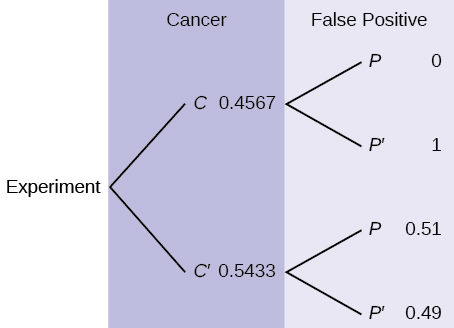| << Chapter < Page | Chapter >> Page > |
Use the following information to answer the next four exercises. [link] shows a random sample of musicians and how they learned to play their instruments.
| Gender | Self-taught | Studied in School | Private Instruction | Total |
|---|---|---|---|---|
| Female | 12 | 38 | 22 | 72 |
| Male | 19 | 24 | 15 | 58 |
| Total | 31 | 62 | 37 | 130 |
Find P (musician is a female).
Find P (musician is a male had private instruction).
P (musician is a male had private instruction) = = = 0.12
Find P (musician is a female is self taught).
Are the events “being a female musician” and “learning music in school” mutually exclusive events?
P (being a female musician learning music in school) = = = 0.29
P (being a female musician) P (learning music in school) = = = = 0.26
No, they are not independent because P (being a female musician learning music in school) is not equal to P (being a female musician) P (learning music in school).
The probability that a man develops some form of cancer in his lifetime is 0.4567. The probability that a man has at least one false positive test result (meaning the test comes back for cancer when the man does not have it) is 0.51. Let: C = a man develops cancer in his lifetime; P = man has at least one false positive. Construct a tree diagram of the situation.

Use the following information to answer the next seven exercises. An article in the New England Journal of Medicine , reported about a study of smokers in California and Hawaii. In one part of the report, the self-reported ethnicity and smoking levels per day were given. Of the people smoking at most ten cigarettes per day, there were 9,886 African Americans, 2,745 Native Hawaiians, 12,831 Latinos, 8,378 Japanese Americans, and 7,650 Whites. Of the people smoking 11 to 20 cigarettes per day, there were 6,514 African Americans, 3,062 Native Hawaiians, 4,932 Latinos, 10,680 Japanese Americans, and 9,877 Whites. Of the people smoking 21 to 30 cigarettes per day, there were 1,671 African Americans, 1,419 Native Hawaiians, 1,406 Latinos, 4,715 Japanese Americans, and 6,062 Whites. Of the people smoking at least 31 cigarettes per day, there were 759 African Americans, 788 Native Hawaiians, 800 Latinos, 2,305 Japanese Americans, and 3,970 Whites.
Complete the table using the data provided. Suppose that one person from the study is randomly selected. Find the probability that person smoked 11 to 20 cigarettes per day.
| Smoking Level | African American | Native Hawaiian | Latino | Japanese Americans | White | TOTALS |
|---|---|---|---|---|---|---|
| 1–10 | ||||||
| 11–20 | ||||||
| 21–30 | ||||||
| 31+ | ||||||
| TOTALS |
Suppose that one person from the study is randomly selected. Find the probability that person smoked 11 to 20 cigarettes per day.
Find the probability that the person was Latino.
In words, explain what it means to pick one person from the study who is “Japanese American AND smokes 21 to 30 cigarettes per day.” Also, find the probability.
To pick one person from the study who is Japanese American AND smokes 21 to 30 cigarettes per day means that the person has to meet both criteria: both Japanese American and smokes 21 to 30 cigarettes. The sample space should include everyone in the study. The probability is .

Notification Switch
Would you like to follow the 'Introductory statistics' conversation and receive update notifications?